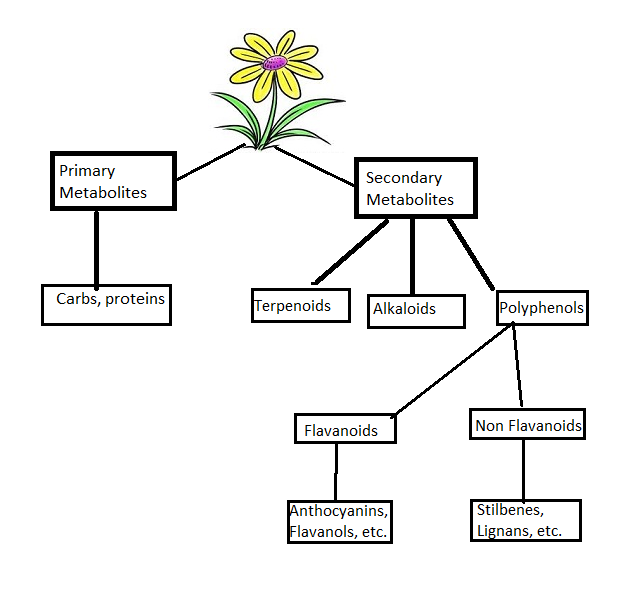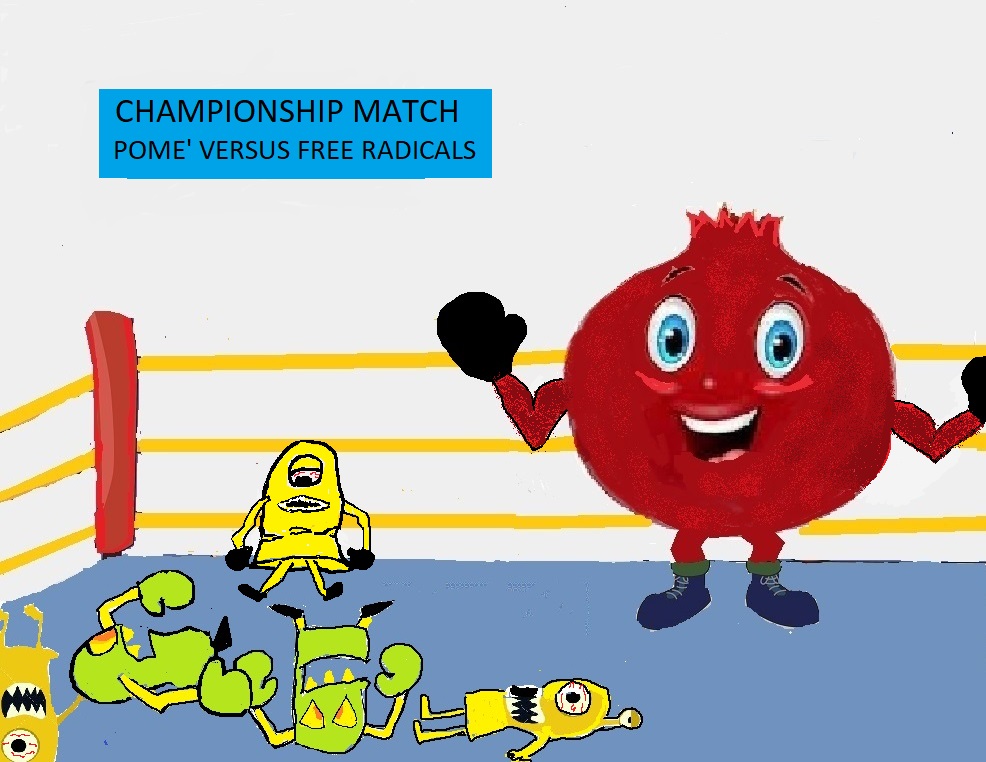- Home
- Polys & Superfood
- What Are Polyphenols in Food
What are Polyphenols in Food?
To answer the question – What are polyphenols in food? – first requires a botany backstory.
Animals in nature have a bunch of physical and chemical ways to protect themselves from predators and pathogens. For example, deer can run really fast and skunks and toads can emit a noxious chemical mix when attacked.
And though they may seem defenseless, plants also have a variety of physical and chemical ways to defend themselves. Have you ever gotten tangled in a briar patch? If so, you know all about thorns, an important physical defense for plants.
But it’s the chemical defenses that protect plants that are important to both plants and people. These chemicals are called polyphenols.
If you’re a plant, polyphenols protect you from environmental dangers like being eaten. And when we eat foods with polyphenols, they protect us from environmental dangers like toxic chemicals.

What Are Polyphenols? - The Botany Backstory
Plant
cells produce two types of compounds; primary metabolites and secondary metabolites].
Primary metabolites include things like carbs, lipids and proteins that plants
need for growth, development, and fitness.
Polyphenols, are plants’ secondary metabolites. They act as a plants environmental defense system.
They protect plants from things like insects, mammalian and insect herbivores, micro-organisms, UV radiation, high temperature, shading, mechanical injury, wounding, and heavy metal toxicity. Polyphenols also play a role in the flavor, color, odor, astringency, oxidative stability and bitterness of plants.
The three broad groups of secondary metabolites are terpenoids, alkaloids, and phenolics, aka polyphenols. Polyphenols are the largest, and most diverse and widely distributed group. This group includes more than 8,000 different types found in plants.
Polyphenols can be divided into two main groups:
Flavonoids (e.g., anthocyanins, flavanols, flavanones, flavonols, flavonones, and isoflavones)
Non-flavonoids (e.g., phenolic acids, xanthones, stilbens, lignans, and tannins) polyphenols.
Phenolic acids, flavonoids, tannins, stilbenes, and lignans are the main groups of polyphenols.
So what are polyphenols in food? They are compounds like genistein, quercetin, kaempferol, daidzein, lutelin, apigenin, myricetin, and biochanin A. And the main food sources of these compounds include fruits, vegetables, grains, green tea, coffee.
What Are Polyphenols In Food Good For?
So now that you know what are polyphenols in food and plants, The next question I need to answer is - What are polyphenols good for. How do they benefit you?
I mentioned earlier what polyphenols are good for in plants. So what are polyphenols good for in your diet? A LOT OF THINGS!
Current studies support the idea that eating foods rich in polyphenols can keep you healthy. Polyphenols are good for protecting you against certain cancers, cardiovascular diseases, type 2 diabetes, osteoporosis, pancreatitis, gastrointestinal problems, lung damage, and neurodegenerative diseases.
Besides protecting your health, polyphenols also support your body’s ability to handle exposure to toxic chemicals.
1. Health Benefits of Polyphenols
During the last few decades, there’s been a lot of research on the health-promoting effects of polyphenols. Many studies have shown that people who follow a polyphenol-rich diet are at a low risk for a range of chronic diseases, like obesity, diabetes, cancer, liver disorders, heart disease, etc.
Many of these health benefits are because polyphenols are great at reducing free radicals in your body, making them excellent antioxidants. Researchers who reviewed over 20,000 published papers on polyphenols also found that more than half of them have antibacterial, antifungal, anti-inflammatory, and antitumor activities.
|
Neurodegenerative Diseases |
Curcumin, resveratrol, and catechins (like epigallocatechin gallate (EGCG)) myricetin, ginsenosides, and ginkgetin may protect against neurodegenerative diseases like Parkinson’s Disease, Alzheimer’s Disease, and Huntington’s Disease. |
|
Inflammation |
Most polyphenols reduce oxidative stress caused by an excess of free radicals in your body. They can also slow, reduce and stop inflammatory responses in your body that create chronic inflammation, a precursor to many diseases. |
|
Cancer |
Flavonoids like anthocyanins, catechins, flavanols, flavones, flavanones, and isoflavones neutralize free radicals and decrease cancer risk by stopping cell growth in tumors. Polyphenols have been shown to have beneficial effects on colon, prostate, epithelial, endometrial, and breast cancer. |
|
Cardiovascular Health |
Flavonoids can improve ventricular health, reduce platelet activity, LDL and inflammation, enzymatic modulation, and lower blood pressure, to increase overall vascular health. |
|
Type 2 Diabetes |
Several polyphenols, like anthocyanins, can prevent and manage type 2 diabetes through anti-inflammatory and antioxidant effects, slowing of starch digestion, and regulation of glucose, leading to better glycemic control. |
|
Obesity |
Catechins, resveratrol, and curcumin are associated with anti-obesogenic effects, potentially through adipocyte oxidation, inhibition of lipogenesis, reduction in inflammation, and increases in energy expenditure, leading to improved weight loss and maintenance. |
2. Toxic
Chemicals and Polyphenols
You
may be wondering why I’m talking about plant polyphenols on a less toxic living
website? Well, it’s because no matter how hard you try, you can’t eliminate all
toxic chemical exposure.
For example, you don’t have control over the toxic chemicals used to clean the
building you work in, the air pollution from nearby industries that you inhale
or all the plastic chemicals in food from the grocery store.
Toxic chemical exposure creates free radicals that damage your health and contribute to obesity, diabetes, chronic inflammation, heart disease, fatty liver disease, cancer and effects your gut health.
And guess what can help protect you from excess free radicals and health problems like obesity, diabetes, chronic inflammation, heart disease, fatty liver disease, cancer and gut problems. You guessed it – Polyphenols!
Your body has its own antioxidant system to destroy free radicals. And it has a detox system, starring your liver, to break down and eliminate toxic chemicals.
Both of these systems can become overwhelmed and so, less efficient at controlling free radicals and detoxing your body because of constant exposure to toxic chemicals.
A lot of the protective effect of polyphenols comes from their impact on the level and activity of your body’s own antioxidant and detox systems. Polyphenols not only protect you directly by destroying free radicals, but they also support enzymes your body needs to break down and eliminate toxic chemicals from your body.
That’s why foods rich in polyphenols are considered superfoods – they are health promoting. The complete opposite of say bacon, which can damage your health. They help your body’s detox system deal with toxic exposure.
So, my two-step plan for a healthy life is to reduce your toxic chemical exposure and increase the polyphenol (superfood) benefits in your diet.
Foods High in Polyphenols
Fruits, especially apples, pears, apricots, cherries,
berries, and grapes, and vegetables, like carrot, tomato, onion, garlic,
cabbage, and celery, contain up to 200–300 miligrams of polyphenols per 100 grams
of their fresh weight.
Phenol-Explorer is a free web portal and database for exploring the plant polyphenols in food. Overall, 502 polyphenols found in 452 foods are indexed in this database.
Using this database, I came up with a list of the Top Ten Polyphenol Foods based on the number of different types of polyphenols in these foods.
They are:
- Blackberries – 103
- Strawberries – 95
- Black Currants – 91
- Highbush Blueberry – 86
- Red Currant – 85
- Black Grapes – 77
- Apples – 66
- Black Tea – 61
- Plums – 59
- Red Raspberries - 55
Now, if you want to include many different types of polys in your diet, these are great foods to eat. BUT, lots of different kinds usually means smaller amounts of each type of polyphenol.
For example, cocoa powder only has 33 different types of polyphenols, but the amount of flavonols cocoa contains is massive. They include high amounts of epicatechin (158 mg/100g), catechin (108 mg/100g) and procyanindin B1 (112 mg/100g).
In comparison, strawberries may have 95 different types of polys but they contain less than 15 mgs total of flavonols and phenolic acids. So if you're interested in adding specific polyphenols to your diet, this list isn't helpful.
Let’s say you wanted to add more quercetin to your diet. The daily intake of quercetin is estimated to be around 5–40 mg/day.
But you can increase these levels to 200–500 mg/day by adding more good sources of quercetin to your diet. So a list of the foods that contain the largest amounts of quercetin would be more useful. This list would include blueberries, apples, cherries, cocoa, tea, blackberries and green leafy vegetables.
It’s important to keep in mind that the way foods are prepared can lower the polyphenol content of foods. For example, the quercetin content of tomatoes and onions can be reduced by up to 80% from boiling, 65% from microwaving, and 30% from frying.
Carotenoids in carrots, zucchini, and broccoli, are reduced the most in frying methods and most retained from boiling methods. The highest polyphenolic content is when vegetables are eaten raw.
Peeling and hulling can also strip foods of their polyphenol content. Red wine has a polyphenol content 10-times greater than white wine because red wine is produced through maceration with polyphenol-rich grape skins.
What all this means is, you could drive yourself crazy trying to target just foods high in polyphenols. Or just foods with high levels of certain polys. Or the best way to prepare high poly foods.
Concentrate instead on finding ways to add a variety of these foods to your diet every day. For example, I eat a raw vegetable meal every day, consisting usually of a veggie filled salad, a smoothie or a flatbread full of sprouts.
But I also like certain vegetables steamed, roasted and sauteed in EVO. I drink coffee, cocoa and green tea. As they say, variety is the spice of life.
Food
or Supplements?
Now, you might be thinking, maybe I’ll just start taking polyphenol supplements. Wouldn’t that be easier? That is a hard pass - No No No. Two reasons.
Reason number 1 is that really brand spanking new research is showing that polyphenols may show synergistic effects. That means they work with other polys and compounds in food to produce even greater benefits.
In other words – Poly 1 provides benefit A, Poly 2 provides benefit B and when they chemically interact in food they create Benefit C.
Polyphenol extracts used in supplements don’t include the synergistic effects and health benefits of a diet naturally rich in polyphenols. These additional benefits include consumption of a high-fiber diet, intake of other and potentially interacting nutrients and non-nutrients.
Reason number 2 is that few studies are focused on the toxicity or safety of consuming polyphenols and consuming levels of polyphenols that are too high is a big concern with supplements. Some manufacturers recommend taking supplements in amounts over 100-times higher than those you would normally get with a Western diet!
Until further studies are performed, a more natural consumption of polyphenol-rich products, like fruits, vegetables, tea, and coffee, is the safest and probably most beneficial approach. Bottom line and my best advice – eat lots of different types of fruits, veggies and beverages and don’t rely on supplements.
So now that you know the answer to what are polyphenols in food, what polyphenols are good for and foods high in polyphenols, check out the articles below. They're full of great info about superfoods that are chock full of polyphenols




